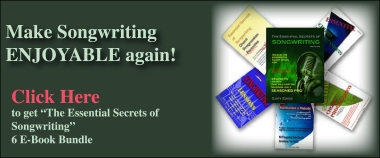 The melody-chord relationship is one we talk about all the time. You can enhance a melody, and in particular its sense of direction and energy, by ensuring that you’re using chords that are functionally clear. The relationship we don’t talk about so much is the connection between lyrics and chords. How listeners react to chords is, in part, a product of culture and upbringing, so it’s hard to be precise with this concept. But as a songwriter, it will help to know that certain kinds of chords tend to elicit certain kinds of reactions. [Continue reading below..]
The melody-chord relationship is one we talk about all the time. You can enhance a melody, and in particular its sense of direction and energy, by ensuring that you’re using chords that are functionally clear. The relationship we don’t talk about so much is the connection between lyrics and chords. How listeners react to chords is, in part, a product of culture and upbringing, so it’s hard to be precise with this concept. But as a songwriter, it will help to know that certain kinds of chords tend to elicit certain kinds of reactions. [Continue reading below..]
_________________
_________________
In other words, you want to be certain that the meaning of your text is being supported by the accompanying harmonies.
There are no rules in this regard, but even the kinds of generalizations I’m about to make will give you at least something to think about and experiment with.
Your song’s lyrics are the main conveyer of meaning to the listener. But you can confuse the listener by choosing chords or chord types that seem contrary to the message you’re trying to communicate.
So, at the risk of being overly general, here are some basic song moods, and the kinds of chords, chord types, or other harmonic structures, that will/might help to convey that mood to the listener. Note that some chords will appear in different lists, depending on tempo, etc:
Lyrical Mood: Happy, care-free, gleeful, etc.
Chord ideas: 1) Standard, major key strong progressions that clearly point to the key; 2) added-6th chords; 3) added-9th chords; 4) chords built on flat-vi chords that move to V.
Lyrical Mood: Sad, down, gloomy, wistful, etc.
Chord ideas: 1) Minor key progressions; 2) progressions that don’t resolve in obvious or predictable ways; 3) flat-VII chords that move to and from the I-chord; 4) Replace the I-chord at the end of a major key progression with the vi-chord (ex: C F Dm G Am).
Lyrical Mood: Melancholy (i.e., lonely, bored, missing someone, etc.)
Chord ideas: 1) Bass pedal tones; 2) add major 7th, especially to IV-chord, and try bVII with a major 7th resolving to IV (ex: C Bbmaj7 F); 3) add 9th to IV-chord; 4) minor iv-chord (ex: C Fm G C).
Lyrical Mood: Determined, “We’re-all-in-this-together”, anthem-like, etc.
Chord ideas: 1) Secondary dominant chords, esp. major-II chord resolving to V (Ex: C F D G), and major-III resolving to vi-chord; 2) inverted pedal point (keep a constant upper note while chords change, regardless of whether that note usually fits the chord); 3) the progression bVI – bVII – I; 4) the bIII chord moving to IV (ex: C Eb F C); 5) Bass pedal tones beneath strong progressions; 6) suspensions on the V chord (ex: C F D Gsus G…).
Lyrical Mood: “I’m moving on”, “I lost my love, but I’m OK”, etc.
Chord ideas: 1) Strong, unambiguous progressions (ex: C F Am G, etc.); 2) Rising bass line (ex: C Dm C/E F… etc.); 3) bVI- bVII- I
You’ll want to be sure that whatever chords you’re using are also supported with a song tempo that reflects the mood of your lyric. But don’t be afraid to experiment. You’d be surprised how jolly a song in a minor key can sound when you support it with a driving tempo and an active rhythm section.
The main point here is this: lyrics and harmonies are important partners in the construction of your song. You can subtly enhance your lyrics, and manipulate the listener by carefully considering the chord you place underneath it.
_________________
 Are you a songwriter who’s STUCK? Get chord progression charts, songwriting lessons, and much more! Download “The Essential Secrets of Songwriting” for your desktop or laptop, and get back to writing great songs!
Are you a songwriter who’s STUCK? Get chord progression charts, songwriting lessons, and much more! Download “The Essential Secrets of Songwriting” for your desktop or laptop, and get back to writing great songs!
Or try “The Essential Secrets of Songwriting” iPhone/iPod Touch App.











This is a neat blog — glad I found it.
This post reminded me of one you made a while back about not loading up your lyrics with too much in terms of adjectives and adverbs. Don’t talk about your “aching pain” or your “languishing heart,” I think were the examples you used.
The adjectives should be in the music. If you talk about the pain in your heart, it’s the job of the music underneath the lyrics to get the aching and languishing across. Lyrics are nouns and verbs — the adjectives are the music itself.
Excellent point! Thanks for writing.
-Gary